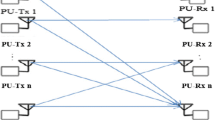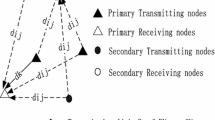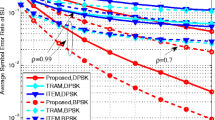Abstract
In this paper, we have numerically computed the channel capacity in fading environment under average interference power constraint with two different adaptation policies for the spectrum sharing in cognitive radio communication systems such as power adaptation and rate and power adaptation for multilevel quadrature amplitude modulation format. However, the small scale fading effect over the transmit power of the secondary transmitter is explored. The rate and power of secondary transmitter is varied based upon the sensing information and channel state information of the secondary link. The channel capacity is maximized for these two policies by considering the Lagrange optimization problem for average interference power constraint.








Similar content being viewed by others
References
Kruys, J., & Qian, L. (2011). Sharing RF spectrum with commodity wireless technologies. New York: Springer.
Federal Communications Commission. (2002). Spectrum policy task force report, FCC 02-155.
Jandral, F. K. (2005). Software defined radio-basics and evolution to cognitive radio. EURASIP Journal on Wireless Communication and Networking, 3, 275–283.
Mitola, J., & Maguire, G. Q. (1999). Cognitive radio: Making software radio more personal. IEEE Personal Communication, 6(4), 13–18.
Biglieri, E., Proakis, J., & Shamai, S. (1998). Fading channels: Information theoretic and communications aspects. IEEE Transactions on Information Theory, 44(6), 2619–2692.
Goldsmith, A. J., & Varaiya, P. (1997). Capacity of fading channels with channel side information. IEEE Transactions on Information Theory, 43(6), 1986–1992.
Khojastepour, M. A., & Aazhang, B. (2004). The capacity of average and peak power constrained fading channels with channel side information. In Proceedings of IEEE wireless communications and networking conference (WCNC’04) (pp. 77–82), Atlanta, CA, USA.
Ghasemi, A., & Sousa, E. S. (2006). Capacity of fading channels under spectrum-sharing constraints. In Proceedings of IEEE international conference on communications (ICC’06) (pp. 4373–4378), Istanbul, Turkey.
Musavian, L., & Aissa, S. (2007). Ergodic and outage capacities of spectrum sharing systems in fading channels. In Proceedings of IEEE global telecommunications conference (GLOBECOM’07) (pp. 3327–3331), Washington, DC, USA.
Ghasem, Amir, & Sousa, Elvino S. (2007). Fundamental limits of spectrum-sharing in fading environments. IEEE Transactions on Wireless Communications, 6(2), 649–658.
Wang, B., & Liu, K.-J.-R. (2011). Advances in cognitive radio networks: A survey. IEEE Journal of Selected Topics in Signal Processing, 5(1), 5–23.
Asghari, V., & Aissa, S. (2008). Resource sharing in cognitive radio systems: outage capacity and power allocation under soft sensing. In Proceedings of IEEE global telecommunications conference (GLOBECOM’08) (pp. 1–5), New Orleans, LA, USA.
Akyildiz, I. F., Lee, W. Y., Vuran, M. C., & Mohanty, S. (2006). NeXt generation/dynamic spectrum access/cognitive radio wireless networks: A survey. Computer Networks: The International Journal of Computer and Telecommun Networking, 50(13), 2127–2159.
Pandit, S., & Singh, G. (2013). Throughput maximization with reduced data loss rate in cognitive radio network. Telecommunication System (online published). doi:10.1007/s11235-013-9858-z.
Yucek, T., & Arslan, H. (2009). A survey of spectrum sensing algorithms for cognitive radio applications. IEEE Communications Surveys & Tutorials, 11(1), 116–130.
Urkowitz, H. (1967). Energy detection of unknown deterministic signals. Proceedings of IEEE, 55(4), 523–531.
Srinivasa, S., & Jafar, S. A. (2010). Soft sensing and optimal power control for cognitive radio. IEEE Transactions on Wireless Communications, 9(12), 3638–3649.
Rezki, Z., & Alouini, M.-S. (2012). Ergodic capacity of cognitive radio under imperfect channel state information. IEEE Transactions on Vehicular Technology, 61(5), 2108–2119.
Parsaeefard, S., & Sharafat, A.-R. (2013). Robust distributed power control in cognitive radio networks. IEEE Transactions on Mobile Computing, 12(4), 609–620.
Zhao, G., Yang, C., Li, G.-Y., Li, D., & Soong, A.-C.-K. (2011). Power and channel allocation for cooperative relay in cognitive radio networks. IEEE Journal of Selected Topics in Signal Processing, 5(1), 151–159.
Kang, X., Garg, H.-K., Liang, Y.-C., & Zhiang, R. (2010). Optimum power allocation for OFDM-based cognitive radio with new primary transmission protection criteria. IEEE Transactions on Wireless Communications, 9(6), 2066–2075.
Li, Q., Li, K. H., & Teh, K. C. (2011). Diversity-multiplexing tradeoff of wireless communication systems with user cooperation. IEEE Transactions on Information Theory, 57(9), 5794–5819.
Sendonaris, A., Erkip, E., & Aazhang, B. (2003). User cooperation diversity-Part I: System description. IEEE Transactions on Communications, 51(11), 1927–1938.
Asghari, Vahid, & Aissa, Sonia. (2010). Adaptive rate and power transmission in spectrum-sharing systems. IEEE Transactions on Wireless Communications, 9(10), 3272–3280.
Goldsmith, A. J., & Chua, S.-G. (1997). Variable-rate variable-power MQAM for fading channels. IEEE Transactions on Communications, 45(10), 1218–1230.
Abramowitz, M., & Stegun, I. A. (1972). Handbook of mathematical functions: With formulas, graphs, and mathematical tables (9th ed.). New York: Dover.
Haykin, S. (2005). Cognitive radio: Brain-empowered wireless communications. IEEE Journal on Selected Areas in Communications, 23(2), 201–220.
Tzeng, S.-S., & Huang, C.-W. (2011). Effective throughput maximization for in-band sensing and transmission in cognitive radio networks. Wireless Networks, 17(4), 1025–1029.
Potier, P., Sorrells, C., Wang, Y., Qian, L., & Li, H. (2014). Spectrum inpainting: A new framework for spectrum status determination in large cognitive radio networks. Wireless Networks, 20(3), 423–439.
Cavers, J.-K. (1972). Variable rate transmission for Rayleigh fading channels. IEEE Transactions on Communications, 20(1), 15–22.
Webb, W.-T., & Steele, R. (1995). Variable rate QAM for mobile radio. IEEE Transactions on Communications, 43(7), 2223–2230.
Alouini, M.-S., & Goldsmith, A.-J. (2000). Adaptive modulation over Nakagami fading channels. Wireless Personal Communications, 13(1–2), 119–143.
Boyd, S., & Vandenberghe, L. (2004). Convex optimization. New York: Cambridge University Press.
Bertsekas, D. P. (1995). Nonlinear programming. Belmont, MA: Athena Scientific.
Suzuki, H. (1977). A statistical model for urban multipath propagation. IEEE Transactions on Communications, 25(7), 673–680.
Sheikh, A. U., Abdi, M., & Handforth, M. (1993). Indoor mobile radio channel at 946 MHz: Measurements and modeling. In Proceedings of IEEE vehicular technology (VTC’93) (pp. 73–76), Secaucus, NJ.
Acknowledgments
The authors are sincerely thankful to the anonymous reviewers for their critical comments and suggestions to improve the quality of the manuscript.
Author information
Authors and Affiliations
Corresponding author
Rights and permissions
About this article
Cite this article
Pandit, S., Singh, G. Channel capacity in fading environment with CSI and interference power constraints for cognitive radio communication system. Wireless Netw 21, 1275–1288 (2015). https://doi.org/10.1007/s11276-014-0849-0
Published:
Issue Date:
DOI: https://doi.org/10.1007/s11276-014-0849-0




